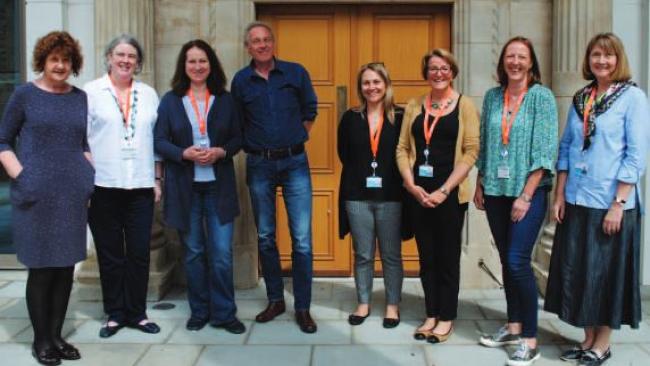
Dr Claudia Tobin
Claudia is an Intellectual Forum Senior Research Associate.
Dr Claudia Tobin is a writer, curator and academic specialising in the intersections between literature and the visual arts in the late nineteenth and early twentieth century.
She was awarded a Leverhulme Early Career Fellowship at the University of Cambridge in 2017 for her research project on colour and the imagination and is currently writing a book on this subject.
Claudia's first book, Modernism and Still Life: Artists, Writers, Dancers (Edinburgh University Press, 2020) explores the genre of ‘still life’ across different media, in prose, poetry, painting, dance, and sculpture of the early- to mid-twentieth century. Other recent publications include Ways of Drawing: Artists' Perspectives and Practices (Thames & Hudson, 2019), co-edited with Julian Bell and Julia Balchin. This book brings together a range of reflections on markmaking by practising artists, teachers and writers. It positions drawing as among the most direct ways of engaging with the world; a way not just of seeing, but of understanding what you see.
Claudia has worked on numerous exhibitions and research projects with museums and arts institutions including Tate Gallery, the National Portrait Gallery, the Paul Mellon Centre for British Art and the Royal Drawing School. She has held fellowships at the Paul Mellon Centre for British Art, Huntington Library California, Paris Diderot University, and is currently a Visiting Fellow at UCL’s Institute of Advanced Studies.
You can contact Claudia at ct526@cam.ac.uk.
What are you working on now?
I am currently writing a book exploring representations of chromatic experience in modern art and literature. As part of my larger project on colour and the imagination, I am curating an exhibition at ÌÀÍ·ÌõÔ´´ on the Jerusalem-born artist Kamal Boullata, focusing on the artist’s handmade books and prints, which explore the interplay of poetry and image, and convergences of colour and architecture. Jerusalem in Exile: Artist’s Books by Kamal Boullata opens on 24 January at West Court Gallery and will travel to Beirut later in the year. It has been a great pleasure to curate the exhibition with the artist’s wife Lily Farhoud, and to work with Elizabeth Fowden and other colleagues at Jesus and the Cambridge Centre of Islamic Art on a symposium which coincides with the exhibition: ‘Meaning and Abstraction in Arab and Islamic Art’.
My recent research on the different ways in which humans, animals and plants experience and respond to colour has prompted me to develop a new project on the sensory lives of plants and their representation in art and culture, in the light of urgent questions about biodiversity. Over the next few months I’ll be researching the Fitzwilliam Museum’s rich botanical art collections and planning an exhibition for the Garden Museum in London.
How has your career to date led to this?
My research has always been energised by collaborations with museums and galleries and by working with contemporary artists. I have contributed to a range of exhibitions exploring the relationship between artists and writers, poetry and performance, including Virginia Woolf: Art, Life, and Vision (2014, National Portrait Gallery), the Tate St Ives exhibition Virginia Woolf: An Exhibition Inspired by her Writings, which travelled to the Fitzwilliam Museum in 2018, and a virtual exhibition, Theatres of War: Experimental Performance in London, 1914-1918, with Grace Brockington and the Paul Mellon Centre for British Art.
Through my work with emerging artists at the Royal Drawing School and as curator of their Lecture and Conversation Series I have the opportunity to discuss ideas with painters, sculptors, poets, curators and film-makers. Working with practising artists has taught me to ask different types of questions and engage in different kinds of encounters to those framed by academic environments.
What one thing would you most want someone to learn from what you've
done or are doing now?
Despite the depressing state of world affairs, my work on and with artists and writers gives me faith in the power of art and the imagination, particularly in times of conflict and division. On a more focused level, I hope I’ve begun to cast a little more light on some of the more overlooked but nevertheless intriguing artistic figures of the early twentieth century, for instance - the pioneering modern dancer Margaret Morris.
What do you think of ÌÀÍ·ÌõÔ´´ and the Intellectual Forum?
Since 2017 I have enjoyed contributing to the rich intellectual and cultural life of ÌÀÍ·ÌõÔ´´. One of the things that first attracted me to the College was its reputation for supporting a flourishing arts programme, notably the bi-annual Sculpture in the Close exhibition. I’ve found the beautiful setting and art collection a great inspiration. Over the last few years I have had the opportunity to contribute to College life as a member of the Works of Art Committee and the Intellectual Forum committee. I have organised film screenings and in-conversations with contemporary artists and an event exploring war, pacifism and contemporary dance with Impermanence Dance Theatre. It has been immensely rewarding to discuss ideas with Fellows across different disciplines and to engage with students by teaching and supervising dissertation projects. I look forward to many more conversations and debates through 2020.
You can meet the rest of the Intellectual Forum team or contact us via email.











